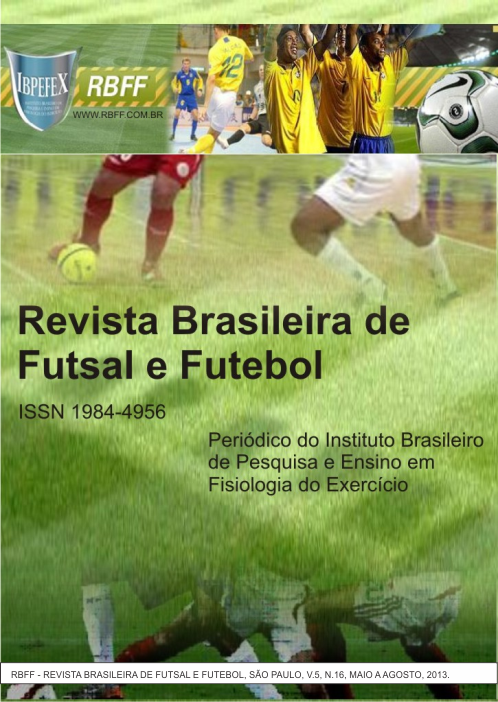Ball possession maintenance modeling in games of the FIFA World Cup 2010TM®
Abstract
The objective of this research focuses on developing models for maintaining ball possession in games of FIFA World Cup South Africa 2010TM®. We analyzed the 64 matches of the 32 participating teams, excluding the presence of four games with extension, for a total sample of n = 120 total teams. The playing field was divided into nine zones. It was used as a criterion the total time of possession of teams in the game to sort the top models (MSup, values > 75o percentile, n = 23 teams), general models (MGer, values ≤ 75o and ≥ 25o percentile, n = 73 teams) and lower models (MInf, values < 25o percentile, n = 24 teams). We used measures of centrality and dispersion and plan inference, normality test of D'Agostino-Pearson (k samples, n ≥ 20), one-way ANOVA for repeated measures followed by post hoc Tukey, with p < 0,01. The results of this study indicate that despite the proposed top modelcharacterized by greater time of possession in games in relation to the general and lower model, there was more time of possession only in areas of the midfield and lateral attack.
References
-Ayres, M.; Ayres, J. R., M.; Ayres, D.L.; Santos, A.A.S. BioEstat 5.0 [Software]. Instituto de Desenvolvimento Sustentável Mamirauá, 2007.
-Bangsbo, J.; Peitersen, B. Defensive soccer tactics: how to stop players and teams from scoring. Champaign, IL: Human Kinectics, 2002.
-Barreira, D.; Martins, L.; Valdemar, P.; Costa, I. T.; Brito, J.; Garganta, J.; Pinto, J.; Souza, C. Analysis of Ball Possession of Spain National Team During Euro 2008. In: The 3rd International Workshop International Society of Performance Analysis of Sport (ISPAS). Lincoln: University of Lincoln. p. 28. 2009.
-Braz, T.V.; Spigolon, L. M. P. ; Borin, J. P. Relação dos microciclos de treinamento com o modelo competitivo técnico-tático de uma equipe de futebol. In: 7a Mostra Acadêmica da UNIMEP. Piracicaba. Ciência, tecnologia e inovação: a universidade e a construção do futuro, 2009. Disponível em: http://www.unimep.br/phpg/mostraacademica/anais/7mostra/5/313.pdf. Acesso em: 04/01/2011.
-Braz, T.V.; Spigolon, L. M. P.; Vieira, N. A.; Borin, J. P. Modelo competitivo da distância percorrida por futebolistas na UEFA Euro 2008. Revista Brasileira de Ciências do Esporte. Vol. 31. p. 177-191. 2010.
-Carling, C.; Williams, M; Reilly, T. Handbook of soccer match analysis: a systematic approach to improving performance. London and New York: Routledge. 2005.
-Castelo, J. Tratado general de fútbol: guía práctica de ejercicios de entrenamiento. 1ed. Badalona. Editorial Paidotribo, 2009.
-Castellano, J. Análisis de las posesiones de balón en fútbol: frecuencia y transición. Motricidad. European Journal of Human Movement. Vol. 21. p. 179-196. 2008.
-Costa, I.T.; Garganta, J.; Greco, P.J.; Mesquita, I. Princípios Táticos do Jogo de Futebol: conceitos e aplicação. Motriz. Vol. 15. Núm. 3. p. 657-668. 2009.
-Garganta, J. Modelação tática do jogo de futebol: estudo da organização da fase ofensiva em equipes de alto rendimento. Tese de Doutorado. Universidade do Porto. Porto. 1997.
-Garganta, J. Trends of tactical performance analysisin team sports: bridging the gap between research, training and competition. Revista Portuguesa de Ciência do Desporto. Vol. 9. Núm. 1. p. 81-89. 2009.
-Gomes, A.C. Treinamento desportivo: estruturação e periodização. 2ªedição. Porto Alegre. Artmed. 2009.
-Hughes, M.; Franks, I. M. Notational Analysis of Sport. 2ed. New York: Routledge. 2004.
-Lago, C. Por que no pueden ganar la liga los equipos modestos? La influencia del formato de competición, sobre el perfil de los equipos ganadores. European Journal of Human Movement. Núm. 18. p. 135-151. 2007.
-Lago, C. The influence of match location, quality of opposition, and match status on possession strategies in professional association football. Journal of Sports Sciences. Vol. 27. Núm. 13. p. 1463-1469. 2009.
-Lago, C.; Ballesteros, J.; Dellal, A.; Gómez, M. Game-related statistics that discriminated winning, drawing and losing teams from the Spanish soccer league. Journal of Sports Science and Medicine. Vol. 9. p. 288-293. 2010.
-Lago, C.; Martín, R. Determinants of possession of the ball in soccer. Journal of Sport Sciences. Vol. 25. Núm. 9. p. 969-974. 2007.
-Maher, A.E. Back Passing, key to Modern Soccer. Scholastic Coach. Vol. 64. Núm. 6. p. 66-67. 1995.
-Paullis, J.C.; Rodriguez, A.P.; Pastor, D.A. Transiciones en la posesión del balón en fútbol: de lo posible a lo probable. Apunts Educación Física y Deportes.1 trimestre. p. 75-81. 2009.
-Platonov, V. N. Tratado geral de treinamento desportivo. São Paulo. Phorte Editora. 2008.
-Szwarc, A. The Efficiency Model of Soccer Player’s Actions in Cooperation with Other Team Players at the FIFA World Cup. Human Movement. Vol. 9. Núm. 1. p. 56-61. 2008.
-Tenga; A.P.C.; Holme, I.; Ronglan, L.T.; Bah, R. Effects of Match Location on Playing Tactics for Goal Scoring in Norwegian Professional Soccer. Journal of Sport Behavior. Vol. 33. Núm. 1. p. 89-108. 2009.
Authors who publish in this journal agree to the following terms:
- Authors retain the copyright and grant the journal the right of first publication, with work simultaneously licensed under the Creative Commons Attribution License BY-NC which allows the sharing of the work with acknowledgment of the authorship of the work and initial publication in this journal.
- Authors are authorized to enter into additional contracts separately for non-exclusive distribution of the version of the work published in this journal (eg, publishing in institutional repository or book chapter), with acknowledgment of authorship and initial publication in this journal.
- Authors are allowed and encouraged to post and distribute their work online (eg, in institutional repositories or on their personal page) at any point before or during the editorial process, as this can bring about productive change as well as increase impact and impact. citation of published work (See The Effect of Free Access).





